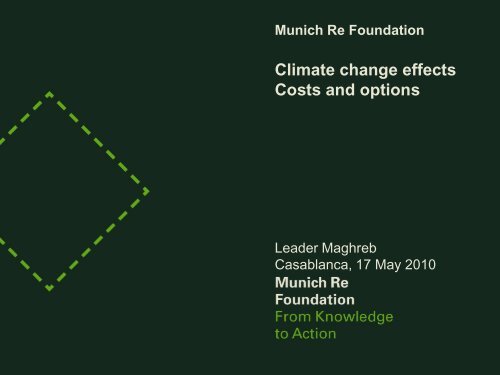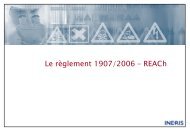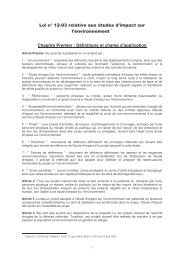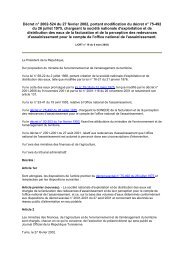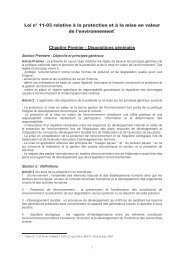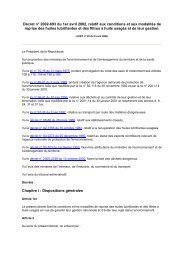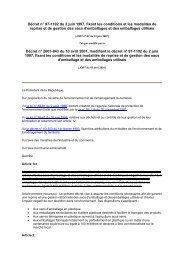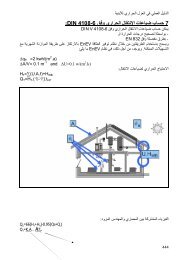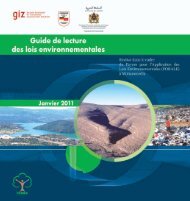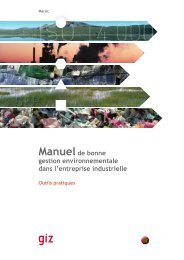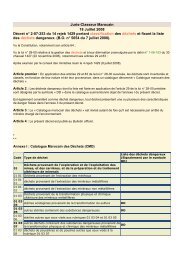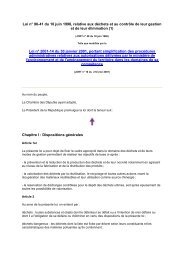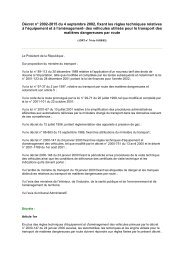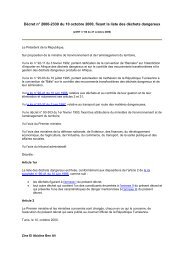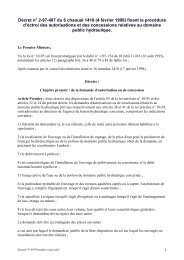Munich Re Foundation
Munich Re Foundation
Munich Re Foundation
You also want an ePaper? Increase the reach of your titles
YUMPU automatically turns print PDFs into web optimized ePapers that Google loves.
<strong>Munich</strong> <strong>Re</strong> <strong>Foundation</strong><br />
Climate change effects<br />
Costs and options<br />
Leader Maghreb<br />
Casablanca, 17 May 2010
Sustainability and Business in Germany<br />
A little history<br />
1970s Increasing environmental damage and awareness<br />
1980s Concept of sustainability developed<br />
1990s Sustainability a signal of responsibility<br />
“Nice to have”<br />
2000+ <strong>Re</strong>gulatory framework develops<br />
“Must have”<br />
2005+ Sustainability creates business oportunities<br />
Modern perspective<br />
Sustainable managers are better risk managers<br />
They tend to see risk and opportunity potentials earlier
Contents<br />
Data<br />
losses and cost estimations<br />
Scientific aspects<br />
climate change effects<br />
Insurance aspects<br />
Microinsurance<br />
Energy and Sustainability<br />
Desertec project<br />
3
Maghreb<br />
Earthquake and tsunami risk mainly in the Mediterranean region<br />
Source: <strong>Munich</strong> <strong>Re</strong> – Globe of Natural Hazards
Global Cost of Climate Change<br />
Famous estimations and reports<br />
1980s/1990s: S. Fankhauser & R. Tol<br />
Expected annual cost of all climate change effects: ca. $300bn<br />
Source: CSERGE GEC Working Paper 92-29 in London 11/93.<br />
R.S.J.Tol(1995): The Damage Costs of Climate Change: Toward More<br />
Comprehensive Calculations. Env. and <strong>Re</strong>source Economics,5,353-374.<br />
2000: Andrew Dlugolecki, UK<br />
The current rate of growth of damage of 10 percent a year will<br />
exceed global gross domestic product by 2065<br />
Source: COP 6, The Hague, UNEP Press conference<br />
2006: Sir Nicholas Stern (UK, ex World Bank)<br />
(integrated assessment model, macro economic models)<br />
By 2050 approx. 5% of global BIP<br />
• weather disasters 0.5-1 %<br />
• „non-market impacts“ (environment, health) up to 20% BIP<br />
Source: STERN REVIEW: The Economics of Climate Change, October 2006
NatCatSERVICE<br />
Natural catastrophes 2009<br />
Worldmap<br />
2009: 850 natural catastrophes<br />
Significant natural catastrophes (selection)<br />
Great natural catastrophes:<br />
2009 no event met the requirement “Great natural<br />
catastrophe”<br />
Geophysical events<br />
(Earthquakes, tsunami, volcanic eruption)<br />
Meteorological events<br />
(Storm)<br />
Hydrological events<br />
(Flood, mass movement)<br />
Climatological events<br />
(Extreme temperature, drought, forest fire)<br />
© 2010 Münchener Rückversicherungs-Gesellschaft, Geo Risks <strong>Re</strong>search, NatCatSERVICE – As at January 2010
Natural Disasters in Morocco since 2000*<br />
Major loss events since 2000<br />
Period Event Affected Area Losses (in USDm)<br />
Fatalities<br />
Overall losses Insured Losses<br />
24.-26.2.2004 Earthquakes N, Al Hoceima, Ait<br />
Kamara<br />
400 0 640<br />
17.-25.11.2002 Floods, Flash Floods W, NW, E,<br />
Mohammedia,<br />
Gharb, Berrechid,<br />
Khourigba, Fez,<br />
Bengueribi, Settat,<br />
Atlantic coast<br />
17.-27.11.2003 Floods, Flash Floods N, NE, Nador, Al<br />
Hoceima<br />
200 140 63<br />
0 0 35<br />
7.-8.2.2009 Floods NW, C, Gharb 0 0 24<br />
23.-28.12.2001 Floods C, Settat, Essaouira 2 0 15<br />
20.-27.12.2000 Floods N, Tetouan,<br />
Tangiers<br />
17.-20.10.2008 Flash floods, severe<br />
storms<br />
C, S, Oujda,<br />
Essaouira, Taza, Al<br />
Houaz, Azilal,<br />
Chichaoua,<br />
Errachidia, Zagora<br />
1 0 _____<br />
0 0 7<br />
* Excluding heat waves and droughts; © <strong>Munich</strong> <strong>Re</strong>, Geo Risks <strong>Re</strong>search, NatCatSERVICE, May 2010<br />
T. R. Loster<br />
May 2010<br />
<strong>Munich</strong> <strong>Re</strong><br />
<strong>Foundation</strong><br />
8
Number<br />
From Knowledge<br />
to Action<br />
Great Natural Disasters 1950 – 2006<br />
Number of events<br />
16<br />
14<br />
© 2007 NatCatSERVICE ® , GeoRisikoForschung, Münchener Rück<br />
Earthquakes, Tsunamis, Volcanos<br />
Weather related events<br />
12<br />
10<br />
8<br />
6<br />
4<br />
2<br />
0<br />
1950 1955<br />
December 2007<br />
1960 1965 1970<br />
<strong>Munich</strong> <strong>Re</strong> <strong>Foundation</strong><br />
1975 1980 1985 1990 1995<br />
Thomas Loster<br />
2000 2005<br />
9
Number<br />
NatCatSERVICE<br />
Global natural catastrophes 1980 – 2009<br />
Trend of events (catastrophe class 1-6)<br />
500<br />
400<br />
300<br />
200<br />
100<br />
1980 1982 1984 1986 1988 1990 1992 1994 1996 1998 2000 2002 2004 2006 2008<br />
Geophysical events<br />
(Earthquake, tsunami,<br />
volcanic eruption)<br />
Meteorological events<br />
(Storm)<br />
Hydrological events<br />
(Flood, mass movement)<br />
© 2010 Münchener Rückversicherungs-Gesellschaft, Geo Risks <strong>Re</strong>search, NatCatSERVICE – As at January 2010
Klimamodelle
12<br />
From Knowledge<br />
to Action<br />
Climate Change Science<br />
June 2008<br />
<strong>Munich</strong> <strong>Re</strong> <strong>Foundation</strong><br />
Thomas R. Loster<br />
<strong>Munich</strong> <strong>Re</strong> <strong>Foundation</strong>
Climate Change Causal Chain<br />
Causes and Effects<br />
Increase in<br />
• greenhouse gases<br />
• temperature air/sea<br />
• humidity<br />
• sea level<br />
• droughts, crop hazards<br />
• rainstorms/floods<br />
• thunderstorms/hailstorms<br />
• windstorms/storm surges<br />
Important<br />
• extreme events<br />
• extreme losses<br />
<strong>Munich</strong> <strong>Re</strong> <strong>Foundation</strong> Thomas Loster<br />
13
Increasing Probabilities of Extremes<br />
Little changes in average values can have tremendous<br />
effects<br />
Example: Heat<br />
normal<br />
warmer climate<br />
cold normal warm hot very hot extreme hot<br />
<strong>Munich</strong> <strong>Re</strong> <strong>Foundation</strong> Thomas Loster<br />
14
Climate Change Tipping Points<br />
Level of global warming and probability of reaching different tipping points<br />
Source: Lenton, T., Schellnhuber, H.J. (2007, Nature)<br />
Thomas Loster
Tropical cyclones extend their impact areas<br />
Tracks of tropical cyclones close to us (2005, 2009)<br />
Most northern and most eastern events in history<br />
Tropical storm Grace<br />
October 2009<br />
Hurricane Vince<br />
October 2005<br />
Thomas Loster
Morrocco in Climate Change Models<br />
Aggravation of the current situation – a summary<br />
Studies by MPAM, World Bank, INRA, FAO, DMN (2008),<br />
reports of GTZ, other reports (models 10x10 km grid):<br />
Physics<br />
• temperature increase +3°C until 2080 (+5°C east, mountains)<br />
• less rainfall (-20% until 2050, -40% until 2080)<br />
• decrease of rain felt in spring and autumn<br />
• more pronounced rain, increase in evapotranspiration<br />
• biggest impact in the south and east<br />
• salt intrusion in coastal areas (Sea Level Rise)<br />
Effects<br />
• higher impact on small and medium farming (>3ha, >15ha)<br />
• social pressure (small farmers, nomads, other competition)<br />
• increasing imports, higher prices for vegetables and fruit<br />
Source: WB/Morocco/FAO climate Change Study 2008, GTZ 2008,<br />
Froehlich/Houdret 2008, Estimations by Rousset/Arrus 2006, STERN<br />
REVIEW: The Economics of Climate Change, October 2006, others 2007
From Knowledge<br />
to Action<br />
Insurance in the rich and the poor world<br />
The wheel of insurance<br />
19<br />
June 2008<br />
<strong>Munich</strong> <strong>Re</strong> <strong>Foundation</strong><br />
Thomas R. Loster<br />
<strong>Munich</strong> <strong>Re</strong> <strong>Foundation</strong>
Growth<br />
From Knowledge to<br />
Action<br />
Insurance Markets<br />
Tools and Data – interest is crucial<br />
Interest<br />
Market<br />
<strong>Re</strong>search<br />
Data<br />
<strong>Munich</strong> <strong>Re</strong> <strong>Foundation</strong> 20
From Knowledge<br />
to Action<br />
Sustainable Solutions<br />
The Desertec Initiative<br />
21<br />
June 2008<br />
<strong>Munich</strong> <strong>Re</strong> <strong>Foundation</strong><br />
Thomas R. Loster<br />
<strong>Munich</strong> <strong>Re</strong> <strong>Foundation</strong>
<strong>Munich</strong> <strong>Re</strong> Publication „Energy situation, problems with<br />
basic resources and insurance published in 1978
<strong>Re</strong>gions with high potential for solar electricity generation<br />
Global distribution of direct normal radiation (needed for CSP* technology)<br />
Source: NASA, DLR<br />
*Concentrated Solar Power<br />
23
Dii GmbH („Desertec Industrial Initiative“)<br />
<strong>Munich</strong> <strong>Re</strong> as the initiator<br />
The world„s<br />
deserts receive<br />
in 6 hours the<br />
amount of<br />
energy, that<br />
mankind<br />
consumes in a<br />
hole year.<br />
solar collector<br />
area necessary to<br />
meet the world„s<br />
energy demand<br />
Source:<br />
DESERTEC<br />
<strong>Foundation</strong><br />
24
The realization of the Desertec concept makes it<br />
possible to achieve a sustainable energy-mix in Europe by 2050<br />
Background, aims and approach<br />
Background<br />
Aims<br />
Approach<br />
• Concept was developed by the Club of Rome and by the TREC Initiative<br />
(Trans-mediterranean <strong>Re</strong>newable Energy Cooperation)<br />
• The German Centre for Aerospace (DLR) conducted several feasibility<br />
studies<br />
• Energy supply in the EUMENA area (Europe, Middle East, North Africa)<br />
with a share of at least 15% of renewable energy in Europe by 2050<br />
• Comprehensive solution to the global problems of the future: Lack of<br />
energy, Water scarcity, climate change and food shortage.<br />
• Solar and wind power from the MENA-region as basic elements of the<br />
future energy-mix (scenario-analysis)<br />
• Consideration of already existing and approved technologies<br />
Solar and wind power generators<br />
High-voltage direct-current transmission<br />
Overall calculated investment needs are approximately 400 Billion € by<br />
2050; in the mid and long term grid parity has to be achieved.<br />
25
Dii GmbH – Shareholders and Associated Partners<br />
Dii Shareholder<br />
Dii Associated Partners<br />
26
The DESERTEC concept:<br />
open for all field-proved technologies<br />
CSP<br />
Concentrating Solar Power<br />
Wind power<br />
PV<br />
Photovoltaic Power<br />
HVDC<br />
High Voltage Direct Current<br />
• Concentration of<br />
sunlight by<br />
mirrors/lenses,<br />
transformation<br />
into heat<br />
• Power generation<br />
by steam turbines<br />
• Heat storage<br />
enables base load<br />
capability<br />
• Conversion of<br />
wind to electricity<br />
by wind turbines<br />
• Onshore/offshore<br />
wind farms<br />
• Limited space<br />
requirements, but<br />
higher power<br />
volatility<br />
• Direct conversion<br />
of sunlight to<br />
electric energy<br />
(photoelectric<br />
effect)<br />
• Large fields with<br />
trackers aligned<br />
to sunlight<br />
• No storage<br />
solutions yet<br />
• Power<br />
transmission over<br />
large distances<br />
• Selected<br />
reinforcement of<br />
existing<br />
transmission grids<br />
• Design for<br />
EUMENA super<br />
grid<br />
27
Long term<br />
Mid term<br />
<strong>Munich</strong> <strong>Re</strong>‟s goals as the initiator of the Dii GmbH<br />
INSURANCE<br />
SOLUTIONS FOR<br />
RENEWABLE<br />
ENERGIES<br />
• Leading role in developing new risk transfer solutions for renewable<br />
energies / new technologies<br />
INVESTMENT<br />
• New (direct) investment options<br />
• Part of <strong>Munich</strong> <strong>Re</strong> strategy to boost investments in renewable energies<br />
CLIMATE<br />
PROTECTION<br />
• Climate change is a tremendous challenge in regard to insurability<br />
• Meets the sustainability strategy of MR<br />
• Takeover of social responsibility<br />
BUSINESS<br />
OPPORTUNITIES<br />
• Rising insurance demand (esp. infrastructure)<br />
• Sharpening of <strong>Munich</strong> <strong>Re</strong>‟s profile as provider for innovative insurance<br />
solutions<br />
28
Dii GmbH – Benefits for all:<br />
EUMENA* and global climate<br />
• New potential for economic, ecological and social development in the Magheb<br />
• Growth, development and employment opportunities for the Maghreb as a<br />
result of substantial private investment<br />
• Greater energy security in the EUMENA countries<br />
• Utilisation of excess energy in, for example, seawater-desalination plants<br />
• Mitigation of the North-South conflict<br />
• <strong>Re</strong>duction of carbon-dioxide emissions and thus a significant contribution to<br />
climate protection targets<br />
*Europe, Middle East and North Africa<br />
29
<strong>Munich</strong> <strong>Re</strong> <strong>Foundation</strong><br />
Thank you<br />
Leader Maghreb<br />
Casablanca, 17 May 2010


